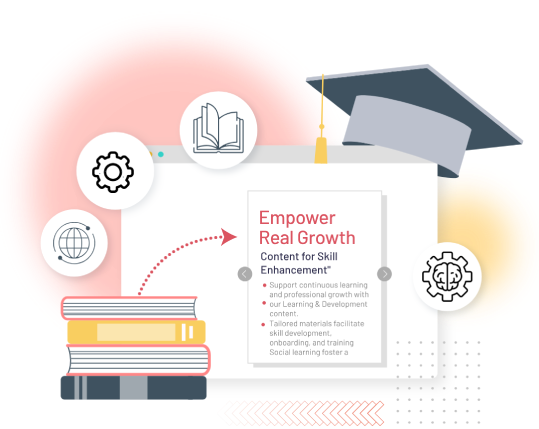
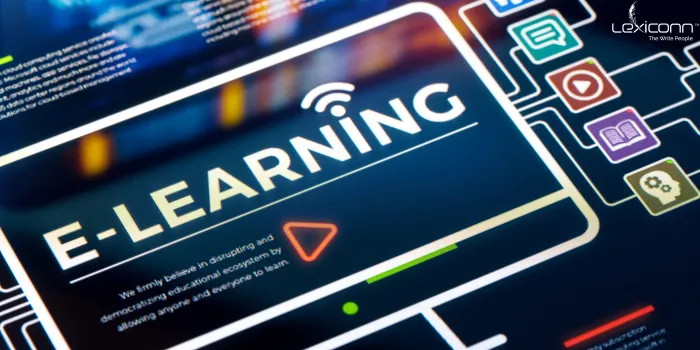
At LexiConn, we've built different eLearning content types for small businesses. Along the way, we've learned something simple but important: no two courses are the same. Different goals. Different people. Different ways to grab attention.
That's why we're sharing the Top 10 eLearning content types you should know. Each one is a tool to make learning stick, spark curiosity, and keep your audience engaged. Ready to see how they can change your course? Let's get started.
Video-based learning for dynamic demonstrations is the star of digital education. Because nothing beats the power of sight and sound combined. Videos draw you in with visuals and lock you in with audio. For visual learners, they're like a masterclass in clarity. For auditory learners, they're a storyteller in action. Together, they boost engagement and make learning stick like glue.
When it comes to eLearning content types, video is the ultimate multitasker:
You can also repurpose live training sessions into evergreen videos or create standalone gems that wow learners.
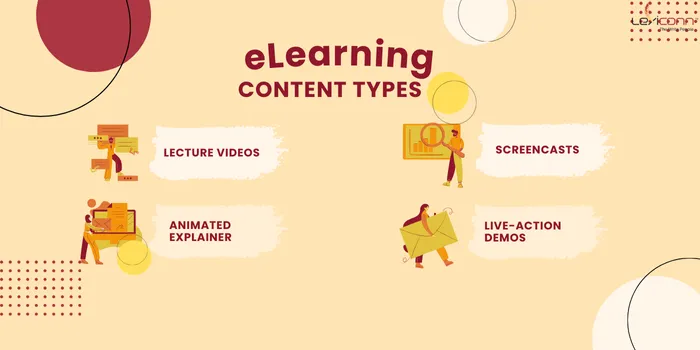
Need to show how something works? Or spark curiosity at the start of a course? Videos do it all. Whether it's a step-by-step tutorial or an inspiring intro, they keep learners hooked and coming back for more.
Microlearning isn't just another trend in digital education—it's the secret to getting things done. With a 94% completion rate compared to traditional courses, it's clear why this approach works: it's designed for how people actually learn today.
Imagine lessons that feel less like a commitment and more like quick wins. Each module is 2–5 minutes long and focuses on one clear takeaway. Bite-sized, purposeful, and easy to digest—exactly what you need for busy schedules and short attention spans.
People don't just start microlearning modules—they finish them. That's the power of simplicity and focus. Whether it's a sales rep squeezing in a quick product update before a pitch or someone revisiting compliance rules in between meetings, microlearning delivers exactly what's needed, when it's needed.
It's the just-in-time approach that keeps engagement high and knowledge retention even higher.
With microlearning, you're not just creating content—you're designing experiences people want to complete. And that's how you turn learning into action.
Let's face it—learning can be boring. But throw in a bit of competition, a dash of curiosity, and the thrill of winning? Now you've got something worth showing up for. Gamified content for increased motivation isn't just fun; it's smart. Studies show it boosts engagement by 60%. That's not just a number—that's a game-changer for digital education.
Gamification taps into something we all love: the feeling of achievement. Whether it's earning a badge, topping a leaderboard, or just beating your own time, it gives learners a reason to care. And when learners care, they retain more. It's like sneaking vegetables into a cake—except this time, the veggies taste amazing.
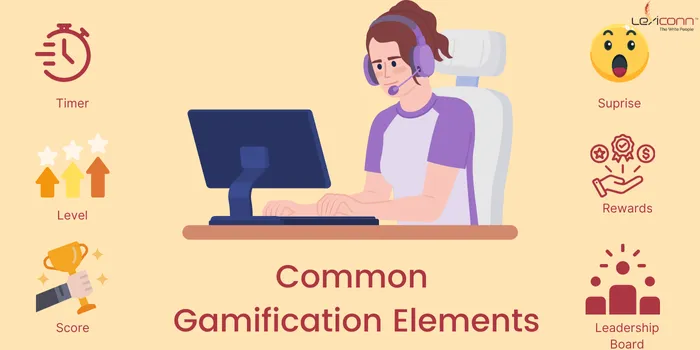
Gamified content isn't just one of those trendy eLearning content types. It's proof that learning doesn't have to feel like a chore.
Imagine this: you're in the middle of a digital education course, and instead of passively watching or reading, you're making decisions that actually matter. That's scenario-based learning, and it's the star of eLearning content types when it comes to practical application.
Why? Because it improves knowledge retention. And who doesn't want learning that sticks?
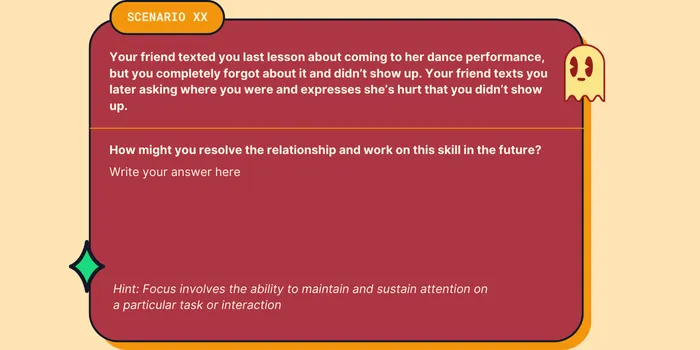
It's like a "choose your own adventure" book but smarter. Learners are placed in realistic situations where they make decisions and see the consequences play out immediately. Whether it's practicing soft skills like customer service or navigating high-stakes fields like safety protocols, this approach brings theory to life.
Here's the magic: you get to make mistakes—without the real-world fallout. It's learning by doing, wrapped in storytelling and interactivity. Plus, let's be honest, it's way more engaging than a slide deck.
Scenario-based learning shines in:
This isn't just another eLearning content type; it's an experience that hooks learners and helps them thrive. Because when you let them practice without the pressure, they're ready to ace the real thing.
Quizzes. They've come a long way from the dreaded pop quiz in school. Now, they're one of the most effective eLearning content types for keeping learners engaged. And here's the kicker: when learners take interactive quizzes, they don't just pass or fail—they learn.
In fact, interactive quizzes boost engagement and knowledge retention by providing instant feedback and reinforcing learning on the spot.
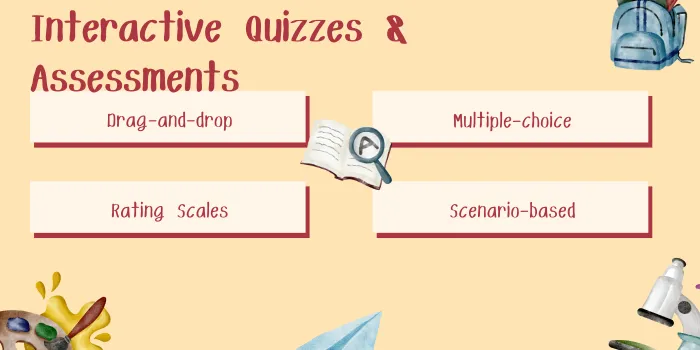
Interactive quizzes are like a mirror—they show learners what they know and where they need to brush up. Immediate feedback keeps the learning loop tight, and the fun, game-like designs make them far less painful than your average test.
Here's a sneaky trick: use question pools to randomize quizzes. It keeps things fresh, discourages answer-sharing, and ensures learners really know their stuff—not just the answers.
Interactive quizzes don't just test knowledge—they build it. And when done right, they're a secret weapon for digital education that learners actually enjoy. Well, mostly.
Imagine learning while driving to work, cooking dinner, or pretending to exercise. That's the magic of podcasts and audio lessons, one of the most versatile eLearning content types. And here's a fun fact: 40% of professionals listen to educational content while multitasking. It's proof that learning doesn't have to stop just because life gets busy.
Podcasts and audio lessons are perfect for auditory learners or anyone who's constantly on the move. They're great for squeezing in a little digital education during the daily grind—no screens, no problem.
Podcasts and audio lessons don't just keep learners engaged—they meet them where they are. Literally. Whether it's a commute, a coffee break, or a kitchen counter, this format makes digital education feel effortless. And isn't that the goal?
Virtual classrooms and webinars are the life of digital education, bringing learners together in real-time, no matter where they are. They're a digital spin on face-to-face learning, and here's why they work: live sessions increase engagement compared to pre-recorded content. Because nothing beats being part of the action.
Think of them as live, interactive spaces where video, chat, polls, and screen sharing come together. They mimic traditional classrooms but with a lot less awkward shuffling of papers.
Perfect for instructor-led training where live input is key or for tackling complex topics that need discussion.
Virtual classrooms and webinars aren't just another eLearning content type. They're proof that learning can be interactive, engaging, and yes, even a little fun. As long as your Wi-Fi holds up.
They say a picture is worth a thousand words—but in digital education, it's worth even more. Infographics and interactive PDFs take the crown for turning the boring into the beautiful. And here's the kicker: visual information is processed 60,000 times faster than text. That's not just science; that's engagement on steroids.
Infographics break down data, processes, or steps into visuals that are easy to grasp. No fluff, no confusion—just clean, digestible design. Interactive PDFs go a step further, adding clickable elements, animations, and even embedded media to bring those visuals to life.
Pair these with microlearning modules as handy references or use them as performance support tools. Think job aids or quick guides—content learners will actually want to use.
Infographics and interactive PDFs aren't just pretty pictures; they're proof that eLearning content types can be simple, smart, and visually stunning—all at the same time.
Blended learning takes the old-school classroom and gives it a digital makeover. It's the ultimate tag team of digital education, combining online modules with face-to-face sessions to keep learners engaged every step of the way. And here's why it works: it saves time. Online modules handle the theory, while in-person sessions focus on hands-on practice. The result? Smarter use of everyone's time and energy.
Blended learning mixes synchronous (live) and asynchronous (self-paced) learning. You get the best of both: the flexibility of online learning and the personal touch of classroom interaction.
Imagine launching a new product. Start with an online module to cover features, specs, and FAQs. Then follow up with an in-person session to demo the product and run live Q & A. Simple, effective, and efficient.
If engagement had a superpower, it would look like VR and AR simulations. These tools take "hands-on practice" to a whole new level by letting learners experiment in virtual environments—safe, controlled, and completely risk-free. No surprise that this eLearning content type boosts retention through full sensory immersion.
VR/AR allows learners to "do" instead of just read or watch. Whether it's performing surgery, piloting a plane, or running a factory line, simulations create experiences that stick without the real-world stakes.
Sure, it comes with higher upfront costs and tech requirements. But when the stakes are high—think healthcare, aviation, or manufacturing—those costs pay off in skills and safety.
VR/AR simulations are proof that digital education doesn't just teach—it transforms.
Creating engaging eLearning content types isn't about picking just one format; it's about finding the perfect mix. Start by aligning content with learning objectives—what's the goal, and how can you best achieve it? For example, videos work for demos, while scenarios build decision-making skills.
Variety is key to engagement. Blend microlearning, video, quizzes, and scenarios to keep things fresh and learners hooked. And don't forget accessibility—always provide transcripts, captions, or plain-text versions to ensure no one is left behind. Finally, use learner feedback and analytics to refine your modules and make them even better.
At LexiConn, we make this process seamless, turning your ideas into cohesive, engaging learning experiences that meet your audience's needs.
Overcomplication is the quickest way to lose learners. Too many bells, whistles, or clunky navigation can overwhelm. Keep the interface simple and intuitive—less is more.
Mobile access is a must. If your modules don't work on a smartphone, you're missing out on a huge slice of your audience. Responsive design isn't optional; it's essential.
Clear objectives matter. Learners need to know, "What's in it for me?" If they can't see the value, they'll check out. And finally, stay fresh. Stale content disengages—review regularly and adapt to new trends or policies.
With LexiConn's expertise, avoiding these pitfalls becomes second nature.
From videos and microlearning to quizzes and VR, the 10 eLearning content types we explored show how digital education can be dynamic and impactful. The key? Combining methods for maximum engagement and learning impact.
Start small: pick 2–3 formats and pilot them in your next module. See what resonates, refine it, and build from there.
As digital learning technologies evolve, staying adaptable is essential. Ready to create an eLearning program that's fresh, engaging, and tailored to your audience? LexiConn is here to make it happen. Let's design something amazing—together.
At LexiConn, we understand the importance of creating dynamic and engaging e-learning content types. With our diverse expertise and the right people, we can craft a customized learning journey that suits your needs.
Book a 30-minute consultation call with us to discuss how we can help you achieve your digital learning goals. Plus, take advantage of our free pilot session to experience firsthand the impact we can make on your learning programs.



I have read and accept the Privacy Policy
Read More